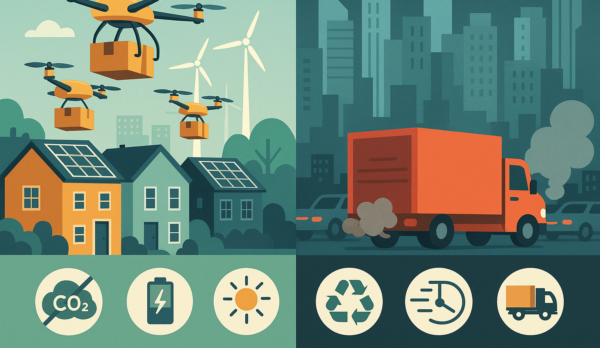The rise of automated drone delivery is transforming the logistics landscape. Promising faster delivery times, reduced labor costs, and expanded access to remote areas, drones are increasingly becoming a tool for last-mile logistics. However, one question looms large: does drone delivery actually help sustainability—or does it worsen the carbon footprint with more energy-consuming devices in the air?
Understanding the Energy Footprint
At first glance, it’s easy to assume that deploying fleets of drones increases energy consumption. After all, each device relies on electricity or battery power, and frequent flights could add up. But the full environmental picture is more nuanced:
- Reduced Vehicle Miles Traveled (VMT)
Traditional delivery trucks consume diesel or gasoline, which emits significant CO₂ per mile. By replacing short urban delivery routes with drones, companies can reduce the number of truck trips, effectively lowering total emissions—even when accounting for drone electricity use.
- Efficiency in Last-Mile Delivery
The last mile is notoriously inefficient. Trucks often travel long distances between stops, idling in traffic, or making repeated trips for small packages. Drones can deliver small parcels directly from hub to consumer, reducing energy consumption per package.
- Electric-Powered Advantage
Many drones run on rechargeable batteries powered by increasingly green electricity grids. As the energy mix becomes cleaner, the carbon footprint of drone operations declines, making them more sustainable over time.
- Lightweight Payloads
Drones are typically used for small, lightweight deliveries. A single drone can carry a few pounds much more efficiently than a full-size truck, especially in congested urban areas. This means the per-pound CO₂ emissions can be substantially lower than traditional methods.
Potential Challenges
While drones can reduce emissions, there are sustainability challenges to consider:
- Battery Production and Disposal: Lithium-ion batteries require energy-intensive production and proper recycling at end-of-life. Without careful management, this can offset some environmental benefits.
- Air Traffic and Noise Pollution: Widespread drone deployment could create congestion in low-altitude airspace and add noise pollution, impacting communities and wildlife.
- Operational Energy Demand: High-frequency deliveries, especially in suburban or rural areas, may reduce efficiency compared to consolidated truck routes.
Maximizing Sustainability Benefits
To ensure drones contribute positively to sustainability, companies should consider:
- Hybrid Delivery Models: Use drones for dense urban areas and trucks for bulk or rural deliveries.
- Battery Recycling Programs: Implement closed-loop recycling to minimize environmental impact.
- Renewable Energy Charging: Power drone fleets with solar, wind, or other green electricity sources.
- Route Optimization: Utilize AI and machine learning to minimize flight distances and energy consumption.
Bottom Line
Automated drone delivery can be a net positive for sustainability, particularly when used strategically for short, urban, last-mile deliveries. While additional devices consume energy, the reduction in truck mileage, idling, and inefficient routing often outweighs the energy cost of drones—especially as battery technology improves and the electric grid becomes cleaner.
Drone delivery isn’t inherently green, but with careful implementation, it can significantly reduce the carbon footprint of last-mile logistics while maintaining speed and convenience.

